🌳 Forest (वन)
Definition, Functions and Current Status.
- The word forest is derived from Latin word ‘foris’ meaning outside the village boundary or away from inhabited land.
- It came by the start of the 14th century.
- In ancient Europe, outer area of village was kept aside for woods growth for timber production purpose.
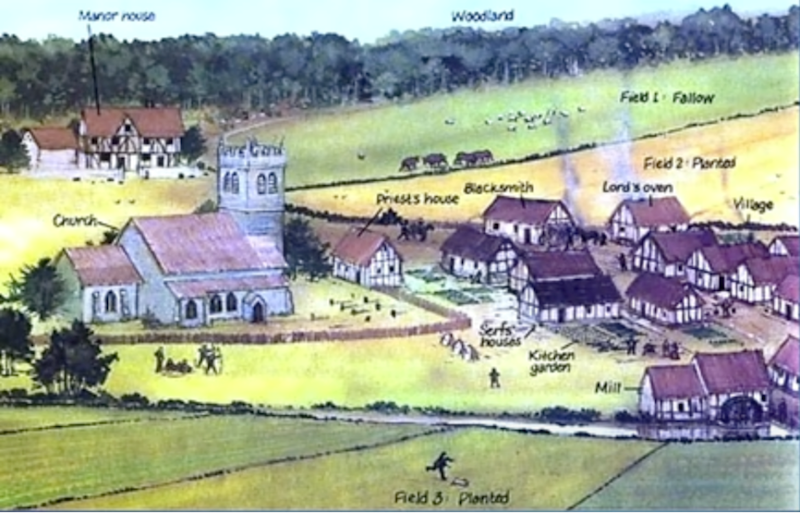
- In General forest is an uncultivated land occupied by natural vegetations with closed or partially closed canopy, which provides shelter to the wildlife.
- Technically, forest is an area set aside for the production of timber and other forest produce or maintained under woody vegetation for certain indirect benefits which it provides, e.g. climatic or protective.
- Ecologically, it is defined as a plant community, predominantly of trees and other woody vegetation, usually with a closed canopy.
- Legally, forest is an area of land proclaimed to be a forest under a forest law.
Functions of forests
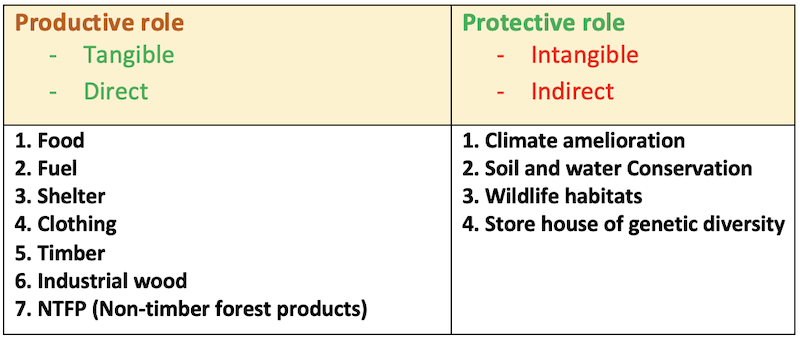
A. Productive Roles
World
- It is estimated that the forest products contribute about
1 %of world gross domestic product (GDP). The annual turnover of timber and other wood products from forests is valued at more than US $247 billion. - Demand for sustainable wood is set to double or even triple through to 2050.
- Apart from that, non-timber products like rubber, cotton, medicinal products, food and so on represent significant economic value.
- The total number of people employed in the formal forestry sector is around 13 million, but those employed in the informal sector total 45 to 50 million.
- The FAO has estimated that the timber, pulp and paper sectors account for $247 billion in global trade exports.
India
- Contribution of forestry to Indian GDP is
1.7 %. - In forest villages, about 300 million local people depend on forest for their subsistence and livelihood and about 70 % of India’s rural population depends on fuelwood to meet domestic energy needs. For about 100 millions of these people, forests are the main source for livelihood and cash income—from fuelwood, non-timber forest products or construction materials.
- More than half of India’s more than 100 million tribal people (8.6% of India’ population) reside in forests and are dependent on them for survival.
- About 170,000 villages, equal to about 27% of India’s villages, are in proximity of forests (forest fringe villages). Forests play an important role in the socio-economic and cultural lives of people in these villages.
- In India, while forest ecosystems contribute only 7% to national GDP, they contribute 57% of rural Indian communities’ livelihoods.
- Forest-based enterprises provide up to 50% of income for 20-30% of labour in India. Timber and non-timber forest products provide direct employment of 350 million-man days.
- Bamboo contributes to the subsistence needs of more than 2.5 billion people, providing livelihood to tribal and forest dwellers.
- The livelihood of about 2 million traditional artisans in India depends on harvesting, processing and selling bamboo products.
- Given that three-quarters of moderately and extremely poor people live in rural areas in India, the loss of natural assets and ecosystem services has a profound effect on global poverty and development.
- Food: Some tree’s rhizomes, fruits, bark, seeds, flowers are edible.
- Fuel: Wood remains the major source of domestic fuel in India.
- Clothing:
Rayonfiber obtained from Eucalyptus spp. Rayon fiber often called artificial silk.

- Shelter: Wood is used for construction of buildings. Ex. Pamyra, Teak, Jack etc.
- Timber: Plywood, Saw milling, paper and pulp and particle boards.
- Industrial wood:

-
Fiber and flosses
- Fibers are obtained from blast tissue of certain woody plants and used for making ropes.
- Flosses are obtained from
Ceiba pentandra. IBPS AFO

- Fibers are obtained from
Agave sisalana,Sterculia urens.
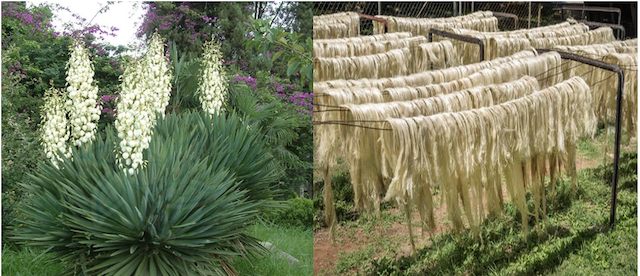
Agave sisalana
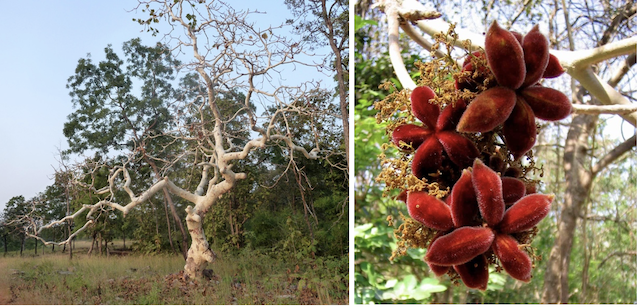
Sterculia urens
-
Grasses and bamboos
- About 30% livestock population graze in the forests.
- Among valuable grasses e.g. Sabai (Eulaliopsis binate) is harvested annually.
- 80,000 tonnes of bamboo are harvested from forest every year.
-
Essential Oil
- An essential oil is a concentrated hydrophobic liquid volatile aroma compound from plants. Essential oil are also known as volatile oils, ethereal oils.
- Essential oil obtained from Eucalyptus, Bursera, Cymbopogan, Sanralum album etc.

Eucalyptus Essential Oil
- Oil seeds
- Many tree species of Madhuca indica (महुआ), Pongamia pinnata (करंज), Shorea robusta (शाल), Azadirachta indica (नीम), Schleichera oleosa (कुसम), Vateria indica (अजकर्ण) etc., produce oil-bearing seeds, which are commercially important. Presently these seeds are used in the soap industry.

- Tans and dyes
- Tannis extracted from bark of wattles (Acacia nilotica, Acacia catchu, Acacia auriculiformis).

- Gums and resins
- Gums and resins are excuded by trees as a result of injury to the bark or wood. Ex.
Sterculia urens,Anogessus latifoliaetc. - Resin is obtained from
Pinus roxburghii.

- Important spices yielding drugs are Rauvolfia serpentina, Hemidesmus indicus, Dioscorea spp, Atropa spp, Datura innoxia etc,
- Spices: Seeds of Carum carvi, barks of Cinnomomum zeylanicum, dried capsules of Elletaria cardomomum (ilaychi).
- Insecticides: Pyrethrum and Neem

- Tendu leaves (Diopyrus melanoxylon) used for bidi making etc.

- Lac is a resinous secretion of insects which feed on forest trees, e.g. Butea monosperma.
- Silkworm is feed on Morus alba or Terminalia alata.
- Honey is produced from forests.
- Fodder and grazing
- About 30% livestock population depend up on forest grazing and leaf fodder supply.
- Eg; Luecaena leucocephala, Albizzia lebbeck, Hardwickia binate.
- Cane
- Canes or rattans are the stems of a climber plant and are used for a large number of household items.
- It is used to make walking sticks, polo sticks, baskets, picture frames, screens, and mats.

B. Protective Role
- Forests as Earth’s air purifiers:
- Amazon Rain Forest: Lungs of the planet Earth.
- Form an effective sink for the carbon dioxide.
- The CO2 percentage in the atmosphere has already reached 0.042 per cent against the normal of 0.03%. Therefore forest helps in reduction this gree house gass and helps in reduction of global mean temperature.
- Climate amelioration:
- Forest increase local precipitation by about 5 to 10% due to their aerographic and microclimatic effect and create conditions favourable for the condensation of clouds.
- Forest reduce temperature and increase humidity. It also reduces evaporation losses.
- Soil and water conservation:
- Forest checks floods. Forests intercept 15 to 30% of the caused due to siltation of river channels caused due to erosion.
Effect of Trees on Forest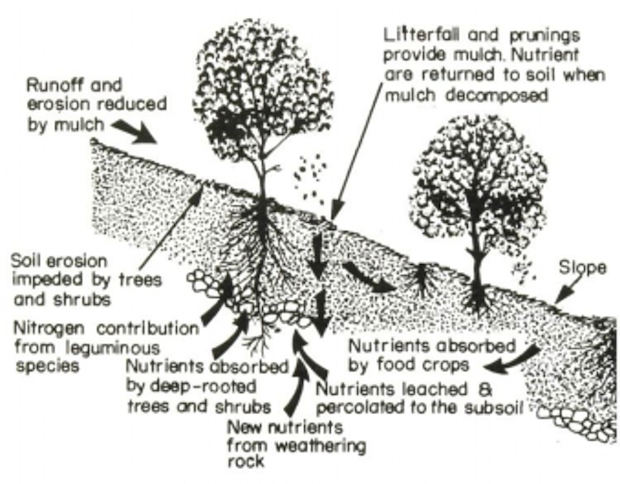
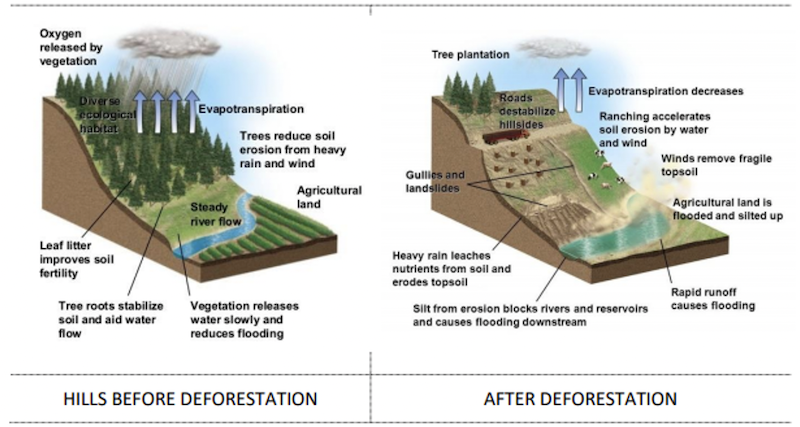

STATUS OF FORESTS IN INDIA
- 31 percent of the world’s land surface, just over 4 billion hectares (incude both natural & plantation). (One hectare = 2.47 acres.). This is down from the pre-industrial area of 5.9 billion hectares.
- About 55 percent of the world’s forests are located in developing countries, with the remaining 45 percent in developed countries.
- The world’s forests are almost equally divided between tropical/subtropical forests and temperate/boreal forests.
- Only about 3 percent of the world’s forests are forest plantations. The remaining 97 percent are natural or semi-natural forests.
- India is one of the 12 mega diversity countries having a vast variety of flora and fauna, commands
7 % of world's biodiversityand supports 16 major forest types, varying from the alpine pastures in the Himalayas to temperate, sub-tropical forests, and mangroves in the coastal areas. - India is 10th in the world in terms of forest area.
- “The total forest cover of the county is
7,13,789 sq km, which is21.71 %and 95,748 sq. km which is2.85 %tree cover of India’s geographical area. - India forest cover in hectare is
71.37 million ha. - Total forest and tree cover is
8,07,276 sq. kmwhich is24.62 %of India’s geographical area. - Russia is number one country in terms of area of forest.

🤔 We will discuss status of Indian forests in deatilin a up comming Lesson.
🏃🏻 Indian State of Forest Report
- The word forest is derived from Latin word ‘foris’ meaning outside the village boundary or away from inhabited land.
- It came by the start of the 14th century.
- In ancient Europe, outer area of village was kept aside for woods growth for timber production purpose.

- In General forest is an uncultivated land occupied by natural vegetations with closed or partially closed canopy, which provides shelter to the wildlife.
- Technically, forest is an area set aside for the production of timber and other forest produce or maintained under woody vegetation for certain indirect benefits which it provides, e.g. climatic or protective.
- Ecologically, it is defined as a plant community, predominantly of trees and other woody vegetation, usually with a closed canopy.
- Legally, forest is an area of land …